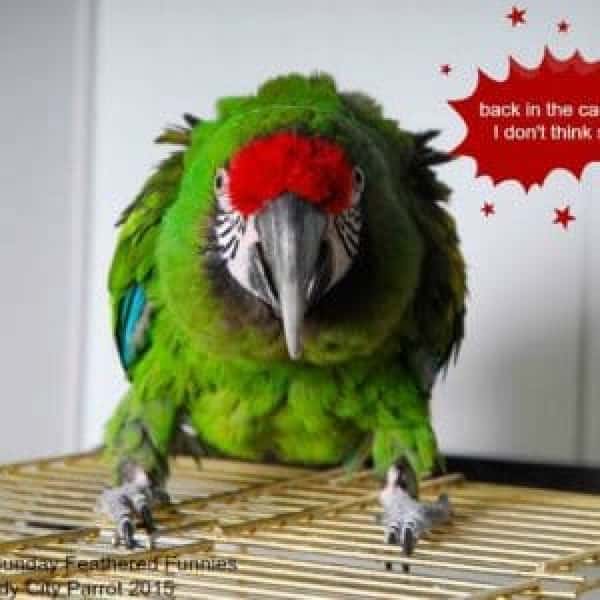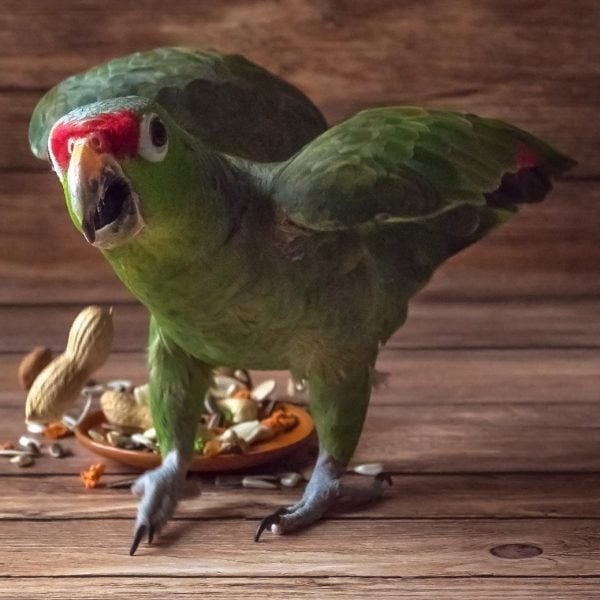Last Updated on by Mitch Rezman
In a recent article in birds.about.com, Patricia Sund a “Pet Birds Expert”, states the case that the word “cage” is brutal, antiquated and out of date.
She feels bird cages should be called a “house” or “room”.She compares it to a child’s “playpen” because we never refer to a child’s playpen as a cage (even though the older wooden styles look like a cage) and she actually finds the words to be “a little offensive” and “harsh” terms for your pet bird’s home.
Another expression she alludes to is “enclosure” the locution used by zoos across the globe furthering her argument that using the word “cage” is considered archaic and barbaric. The ensuing logic is that because the bird lives in your home the bird’s “enclosure” is their home.
We all love our homes. When we’re away for extended periods we think about returning home. On lazy Sunday afternoons, we relish the rare opportunity to lounge around our home. That’s because they are our “homes”.
Here’s the thought process, the fantasy, the defining moment when you thought a bird was the right fit for you and your lifestyle. You would get the biggest most expensive cage money could buy.
You’d fill it with dozens of fun colorful and interactive bird toys, lots of accessories, ladders, and rope perches. Then you’d make sure you had several feeder dishes with seeds, pellets treats, and fresh foods. Lots of fresh water and a water bottle and even a bird bath. It would be the “best bird cage ever!”
Now, this is where I, the strange bearded guy somehow slip into your new bird fantasy. In a low soothing voice nowhere close to my nasal midwest accent I say “Here’s your first lesson in bird care Virginia. It’s a lazy Sunday warm & sunny afternoon, let’s move this beautiful cage by this big window.”
Now let’s open the window lift the screen for lots of fresh air and then open the bird cage door. Oh, look! your bird just left the “best bird cage ever” and flew out the window. It’s return is doubtful given the strong winds today.”
Now you’re standing there dumbstruck and no longer wondering what I was doing in your fantasy to begin with but why I ruined your fantasy by letting your new bird fly away. So I give to you the first rule of caged bird care in that same low soothing voice before I morph into a thousand points of light.
“Because it’s a cage, Virginia,
not a home – your bird doesn’t want to be in it.”
Readers of this caged bird care blog will note that I address all of you as “caged bird keepers”. That’s what you are. Bird cages are designed to be bird jails. Outside of the cage and lacking your supervision, birds will walk or fly around your home destroying most of everything in their path, and eventually hurt themselves by doing things like chewing on electrical cords or finding long forgotten glue mouse traps or poisonous ant traps.
If you look at a species like blue and gold macaws, in the South American wilderness they reside in 30 or 40 square-mile areas. A pair of birds will fly 25 to 50 miles a day with as many as 50 stops along the way foraging for food. At night they congregate with a flock of many other macaws hidden among trees with a great deal of foliage. Living in a high social setting (the godfeathers of social media), activities are planned. Relationships form, families are hatched and there’s always something to do. In the rainforest, they get a bath almost every day.
We chop off the majority of these winged creatures flight feathers because it suits us for them not to fly – “they’ll fly into a wall” is the biggest reason we hear for wing clipping. We feed them highly nutritious but counter-intuitive things like bird food pellets (there are no pellet trees in the rain forest), deprive them of sexual partners, and replace their choice of trees with 10 square feet of wrought iron 6 feet off the ground (if they’re lucky to get a cage that big) make it dark outside at 5:00 in the afternoon (when they instinctively expect the sun to set at 8 or 9) and then we lock them in the “cage” for 10 hours a day while we’re at work.
We let them sleep on inappropriate perches (hardwood & pedicure perches) for thousands of hours of their lifetime. We trim their nails and put them back on slippery plastic and wood perches (further challenging their lack of balance because of the aforementioned clipped wings). We give them little or no exercise to speak of. We offer little if any flock type socialization and then we wonder that in spite of all of the love and money:
- why do we fail at keeping them as pets?
- why do they self mutilate?
- why do they scream so much?
- why do they chew up furniture & walls?
- why are they so messy?
- why do they have to poop so much?
It’s when we realize that bringing a bird into our home and putting it in metal structure a.k.a. bird cage is much like you or me moving into a condo on Mars. It’s a much different environment than we were designed for and intuitively expect to live in before we left earth.
If you haven’t already, it’s time to re-think this whole caged bird-keeping thing. Stop reading crap on the internet and start thinking like a bird.
In Ms.Sund’s article, she quotes Ann Brooks founder of the Phoenix Landing Foundation who “hates it” when people refer to an operation as a “parrot rescue”. Trust me, parrot rescues are just that. Need more convincing? watch this:
We took the birds out of the sky, it’s our responsibility to give them the best care possible. Simply changing the name of the device that keeps them captive will not begin to compensate for the time and energy necessary to understand, cultivate and develop the proper caged environment for your pet bird. We’re here to help.
Written by Mitch Rezman
Approved by Catherine Tobsing
Approved by Catherine Tobsing
Author Profile
Latest entries
 The Traveling BirdJune 26, 2025Can You Name 5 Parrot Species That Are Living Wild in the USA?
The Traveling BirdJune 26, 2025Can You Name 5 Parrot Species That Are Living Wild in the USA? Bird BehaviorJune 26, 2025How is it Parrots Are Problem Solvers Social Animals and Even Use Tools?
Bird BehaviorJune 26, 2025How is it Parrots Are Problem Solvers Social Animals and Even Use Tools? Bird & Parrot AnatomyJune 25, 2025How a Tiny Chemical Modification Makes Parrots Nature’s Living Paintings
Bird & Parrot AnatomyJune 25, 2025How a Tiny Chemical Modification Makes Parrots Nature’s Living Paintings PigeonsJune 20, 2025How Do Parrots Thrive in Cities Outside Their Native Habitats?
PigeonsJune 20, 2025How Do Parrots Thrive in Cities Outside Their Native Habitats?




